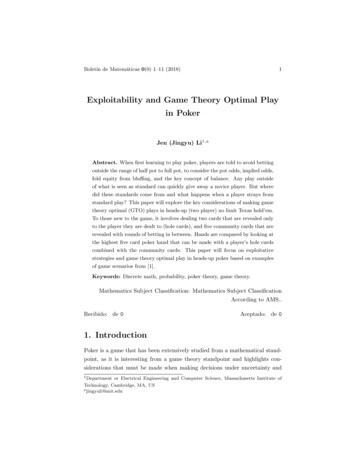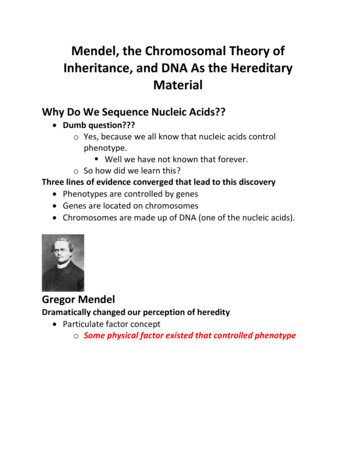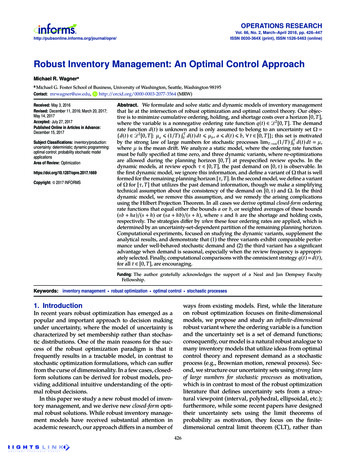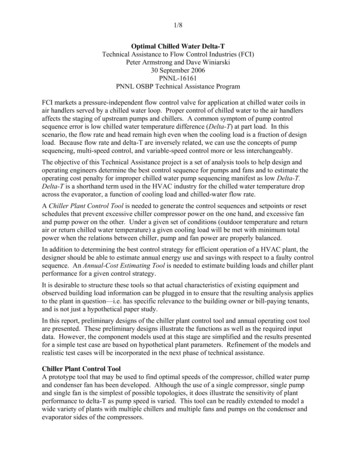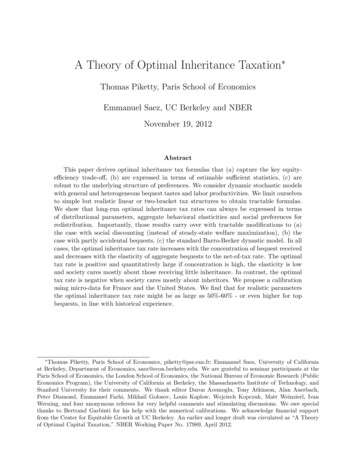
Transcription
A Theory of Optimal Inheritance Taxation Thomas Piketty, Paris School of EconomicsEmmanuel Saez, UC Berkeley and NBERNovember 19, 2012AbstractThis paper derives optimal inheritance tax formulas that (a) capture the key equityefficiency trade-off, (b) are expressed in terms of estimable sufficient statistics, (c) arerobust to the underlying structure of preferences. We consider dynamic stochastic modelswith general and heterogeneous bequest tastes and labor productivities. We limit ourselvesto simple but realistic linear or two-bracket tax structures to obtain tractable formulas.We show that long-run optimal inheritance tax rates can always be expressed in termsof distributional parameters, aggregate behavioral elasticities and social preferences forredistribution. Importantly, those results carry over with tractable modifications to (a)the case with social discounting (instead of steady-state welfare maximization), (b) thecase with partly accidental bequests, (c) the standard Barro-Becker dynastic model. In allcases, the optimal inheritance tax rate increases with the concentration of bequest receivedand decreases with the elasticity of aggregate bequests to the net-of-tax rate. The optimaltax rate is positive and quantitatively large if concentration is high, the elasticity is lowand society cares mostly about those receiving little inheritance. In contrast, the optimaltax rate is negative when society cares mostly about inheritors. We propose a calibrationusing micro-data for France and the United States. We find that for realistic parametersthe optimal inheritance tax rate might be as large as 50%-60% - or even higher for topbequests, in line with historical experience. Thomas Piketty, Paris School of Economics, piketty@pse.ens.fr; Emmanuel Saez, University of Californiaat Berkeley, Department of Economics, saez@econ.berkeley.edu. We are grateful to seminar participants at theParis School of Economics, the London School of Economics, the National Bureau of Economic Research (PublicEconomics Program), the University of California at Berkeley, the Massachusetts Institute of Technology, andStanford University for their comments. We thank editor Daron Acemoglu, Tony Atkinson, Alan Auerbach,Peter Diamond, Emmanuel Farhi, Mikhail Golosov, Louis Kaplow, Wojciech Kopczuk, Matt Weinzierl, IvanWerning, and four anonymous referees for very helpful comments and stimulating discussions. We owe specialthanks to Bertrand Garbinti for his help with the numerical calibrations. We acknowledge financial supportfrom the Center for Equitable Growth at UC Berkeley. An earlier and longer draft was circulated as “A Theoryof Optimal Capital Taxation,” NBER Working Paper No. 17989, April 2012.
1IntroductionThere is substantial controversy both in the public policy debate and among economists aboutthe proper level of taxation of capital income and inheritances. The public debate centers aroundthe equity vs. efficiency issues. On the one hand, inequality between individuals arises not onlyfrom inequality in labor income but also from inequality in inheritances received. Piketty (2011)shows that bequests can be quantitatively important and tend to grow very rapidly in low-growthmature economies such as France. Furthermore, in contrast to labor income, individuals arehardly responsible for the inheritances they receive. Inheritance taxation redistributes fromthose receiving large inheritances toward those who do not. On the other hand, inheritancetaxation also hurts those who accumulate wealth to leave inheritances for the welfare of theirheirs, and hence might discourage wealth accumulation in the first place.In the economic debate, there is a wide array of models and results capturing the issue ofoptimal capital/inheritance taxation. Those models differ primarily in terms of preferences forsavings/bequests and the structure of economic shocks. In the infinite life model of Chamley(1986) and Judd (1985) with no stochastic shocks, the optimal capital income tax is zero in thelong-run because a constant capital income tax creates a growing distortion on inter-temporalchoices. In a life-cycle model with no bequests and homogeneous preferences for savings, laborincome is the sole source of inequality and optimal capital income taxation is zero because anonlinear earnings income tax is a more efficient tool for redistribution (Atkinson and Stiglitz,1976). However, many subsequent studies have shown that those famous zero capital tax results can be overturned by relaxing each of the key hypotheses.1 While those extensions provideimportant insights, it is hopeless to be able to ever measure directly the exact individual preferences’ distributions to tell apart the different models. This leaves the current field of optimalcapital income taxation fairly scattered with no clear policy implications as different–yet difficultto test–assumptions for bequest behavior lead to different formulas and magnitudes.In this paper, we make progress on this issue by showing that optimal inheritance taxformulas can be expressed in terms of estimable “sufficient statistics” including distributionalparameters, behavioral elasticities and social preferences for redistribution. Those formulas arerobust to the underlying primitives of the model and capture the key equity-efficiency trade-off1The most studied extensions leading to non-zero capital income taxes are: (a) presence of idiosyncraticlabor income shocks, (b) accidental bequests, (c) bequests givers caring about pre-tax or post-tax bequestsrather than the utility of heirs, (d) long-run steady-state welfare maximization, (e) time-invariant taxes, (f) lackof government commitment (Kopczuk 2013 and Diamond and Werning 2013 provide recent surveys).1
in a transparent way. This approach has been fruitfully used in the analysis of optimal laborincome taxation (Piketty and Saez, 2013 provide a recent survey). We follow a similar routeand show that the same equity-efficiency trade-off logic also applies for inheritance taxation.This approach successfully brings together many of the main disparate results obtained in theliterature on optimal capital tax theory.We first consider in Section 2 dynamic stochastic models with general and heterogeneouspreferences for bequests and ability for work where donors care solely about the net-of-tax bequest they leave to their heirs, and where the planner maximizes long-run steady-state welfare.This is the simplest case to illustrate the key trade-off transparently. Importantly however, weshow in Section 3 that our results carry over with tractable modifications to (a) the case withsocial discounting (instead of steady-state welfare maximization), (b) the case with partly accidental bequests, (c) the standard Barro-Becker dynastic model with homogeneous discounting.In all cases, the problem can be seen as an equity-efficiency trade-off where the optimalinheritance tax rate increases with the concentration of bequests received, decreases with theelasticity of aggregate bequests to the net-of-tax rate, and decreases with the value that societyputs on the marginal consumption of bequest receivers and bequest leavers. The optimal taxrate is positive and quantitatively large if the elasticity is low, bequests are quantitatively largeand highly concentrated, and society cares mostly about those receiving little inheritance. Incontrast, the optimal tax rate is negative when society cares mostly about inheritors.As in the public debate, the desirability of taxing bequests hinges primarily on wealth inequality and mobility and how social marginal welfare weights are distributed across groups.The optimal tax rate is zero when the elasticity of bequests is infinite nesting the zero capitaltax Chamley-Judd result.2 In contrast to the Atkinson-Stiglitz zero capital tax result in thelife-cycle zero-bequest model, inheritance taxation is non-zero even with optimal labor taxationbecause with bequests, inequality is bi-dimensional ands labor income is no longer the unique determinant of lifetime resources. Indeed, in the OLG zero-bequest version of our dynamic model,labor income and capital income are perfectly correlated, inequality is uni-dimensional and thenatural optimum capital income tax rate is zero under standard assumptions for preferences.The case with social discounting and government debt shows that cross-sectional redistribution2In the altruistic dynasty case, the elasticity includes an anticipatory component as wealth accumulationdecisions are affected before a tax change takes place. In the Chamley-Judd case with no stochastic shocks, thisanticipatory elasticity is always infinite, even when preferences are tweaked (with endogenous discount rates) tomake the long-run steady-state elasticity of bequests with respect to the long-run net-of-tax rate finite.2
issues are orthogonal to optimal capital accumulation issues.Importantly, we limit ourselves to extremely simple linear (or two-bracket) tax structureson inheritances and labor income to be able to obtain tractable formulas in models with veryheterogeneous preferences. The advantages are that, by necessity, our tax system is well withinthe realm of current practice and the economic trade-offs appear transparently. This “simple taxstructure” approach is in contrast to the recent new dynamic public finance (NDPF) literature(Kocherlakota, 2010 provides a recent survey) which considers the fully optimal mechanismgiven the informational structure. The resulting tax systems are complex–even with stronghomogeneity assumptions–but potentially more powerful to increase welfare. Therefore, weview our approach as complementary to the NDPF approach.3As an illustration of their use for policy recommendations, we propose in Section 4 a numerical simulation calibrated using micro-data for the case of France and the United States. Wefind that for realistic parameters the optimal inheritance tax rate might be as large as 50%-60%- or even higher for top bequests, in line with historical experience. To our knowledge, this isthe first time that a model of optimal taxation delivers tractable and estimable formulas thatcan be used to analyze real world inheritance tax rates.2Optimal Steady-State Inheritance Tax Rate FormulaWe consider a dynamic economy with a discrete set of generations 0, 1, ., t, . and no exogenous growth. Each generation has measure one, lives one period, and is replaced by the nextgeneration. Individual ti (from dynasty i living in generation t) receives pre-tax inheritancebti 0 from generation t 1 at the beginning of period t. Inheritances earn an exogenousgross rate of return R per generation. Individual ti has exogenous pre-tax wage rate wti , workslti , and earns yLti wti lti at the end of period and then splits lifetime resources (the sum ofnet-of-tax labor income and capitalized bequests received) into consumption cti and bequestsleft bt 1i 0. We assume that there is a linear labor tax at rate τLt , a linear tax on capitalizedbequests at rate τBt , and a lumpsum demogrant Et .4 Individual ti has utility function V ti (c, b, l)3Farhi and Werning (2010) analyze optimal bequest taxation in a two-period Atkinson-Stiglitz model and ina NDPF model. In both cases the benchmark is zero bequest taxes and they show that caring about inheritorsleads to negative but progressive bequest tax rates. In appendix A.4 we analyze the links between our analysisand theirs and show that their results have simple counter-parts within our linear tax structure analysis. Wealso discuss in which ways more complex tax mechanisms could in practice improve welfare.4Note that the τBt taxes both the raw bequest bt 1i and the lifetime return to bequest (R 1) · bt 1i , so itshould really be interpreted as a broad-based capital tax rather than as a narrow inheritance tax.3
increasing in consumption c cti and net-of-tax capitalized bequests left b Rbt 1i (1 τBt 1 ),and decreasing in labor supply l lti . Hence, the individual maximization problem is:maxlti ,cti ,bt 1i 0V ti (cti , Rbt 1i (1 τBt 1 ), lti ) s.t. cti bt 1i Rbti (1 τBt ) wti lti (1 τLt ) Et . (1)The individual first order condition for bequests left is Vcti R(1 τBt 1 )Vbti if bt 1i 0.We denote by bt , ct , yLt aggregate bequests received, consumption, and labor income ingeneration t. We assume a stochastic process for utility functions V ti and for wage rates wtisuch that, with constant tax rates and demogrant, the economy converges to a unique ergodicsteady-state.5 In the long-run, the position of each dynasty is independent of the initial position.Our model allows for heterogeneity in preferences for work and bequests and work ability.We assume that the government chooses steady-state long-run policy E, τL , τB to maximizesteady-state social welfare, a weighted sum of individual utilities with Pareto weights ωti , subjectto a period-by-period budget balance Et τBt Rbt τLt yLt .6ZSW F max ωti V ti (Rbti (1 τB ) wti lti (1 τL ) E bt 1i , Rbt 1i (1 τB ), lti ).τL ,τB(2)iNote that, in the ergodic equilibrium, social welfare is constant over time. Taking the demograntE as fixed, τL and τB are linked to meet the budget constraint, E τB Rbt τL yLt . The aggregatevariable bt is a function of 1 τB (assuming that τL adjusts), and yLt is a function of 1 τL(assuming that τB adjusts). Formally, we can define the corresponding long-run elasticities as:eB 1 τBdbtbt d(1 τB )and eL E1 τL dyLtyLt d(1 τL ).(3)EThat is, eB is the long run elasticity of aggregate bequest flow (i.e. aggregate capital accumulation) with repsect to the net-of-bequest-tax rate, while eL is the long run elasticity ofaggregate labor supply with repsect to the net-of-labor-tax rate.RWe denote by gti ωti Vcti / j ωtj Vctj the normalized social marginal welfare weight on individual ti. gti measures the social value of increasing consumption of individual ti by 1 (relativeto distributing the 1 equally across all individuals).Consider a small reform dτB 0, budget balance with dE 0 requires that dτL is such that: τBτLRbt dτB 1 eB dτL yLt 1 eL.(4)1 τB1 τL5All we need to assume is an ergodicity condition for the stochastic process for V ti and wti : Whatever one’sparental taste or productivity, there is always a positive probability of having any other taste or productivity.See Piketty and Saez (2012) for a precise mathematical statement and concrete examples. Random taste shockstypically generate Pareto distributions with realistic levels of wealth concentration–which are difficult to generatewith labor productivity shocks alone. Random shocks to rates of return would work as well.6Exogenous (non transfer) government spending Ht can be added without affecting the analysis.4
Using the fact that bt 1i and lti are chosen to maximize individual utility and applying theenvelope theorem, the effect of the reform dτB , dτL on steady-state social welfare is:ZdSW F ωti Vcti · (Rdbti (1 τB ) Rbti dτB dτL yLti ) ωti Vbti · ( dτB Rbt 1i ).iAt the optimum, dSW F 0. Using the individual first order condition Vcti R(1 τB )Vbtiwhen bt 1i 0, expression (4) for dτL , and the definition of gti , we have: Z1 eB τB /(1 τB ) yLtibt 1iRbt dτB dτB,0 gti · dτB Rbti (1 eBti ) 1 eL τL /(1 τL ) yLt1 τBiwith eBti 1 τBdbtibti d(1 τB )(5)the individual elasticity of bequest received.7EThe first term captures the negative effect of dτB on bequest received (the direct effect andthe dynamic effect via reduced pre-tax bequests), the second term captures the positive effectof reduced labor income tax, the third term captures the negative effect on bequest leavers.To capture distributional parameters of earnings, bequests received, and bequests left, weuse the ratios–denoted with an upper bar–of the average weighted by social marginal welfareweights gti to the unweighted average. Hence, ȳL , b̄received , b̄left , are the population averages ofgti · yLti /yLt , gti · bti /bt , gti · bt 1i /bt 1 . Such ratios are below one if the variable is lower for thosewith high social marginal welfare weights. Finally, let êB be the average of eBti weighted bygti bti .8 Dividing (5) by Rbt dτB , the first order condition is rewritten as:0 b̄received (1 êB ) b̄left1 eB τB /(1 τB )ȳL ,1 eL τL /(1 τL )R(1 τB )henceSteady-State Optimum. The optimal tax rate τB that maximizes long-run steady state socialwelfare with period-by-period budget balance is given by:hi h receivedieL τLb̄1 b̄left1 1 1 τ·(1 ê) BȳLR ȳLLhiτB .eL τL b̄received1 eB 1 1 τ(1 ê)BȳLL(6)Five important points are worth noting about this formula.First, the presence of R in formula (6) is a consequence of considering steady-state maximization, i.e., no social discounting. As shown in Section 3.1, with social discounting at rate 1, R should be replaced by R . Furthermore, in a closed economy with government debt,dynamic efficiency implies that the modified Golden, R 1, holds. Hence, formula (6) continues to apply in the canonical case with discounting and dynamic efficiency by replacing R by78Note that eB is the bequest-weighted population average of eBti .êB is equal to eB (bti -weighted average of eBti ) if individual bequest elasticities are uncorrelated with gti .5
one in equation (6). This also remains true with exogenous economic growth.9 Therefore, if onebelieves that the natural benchmark case involves dynamic efficiency and no social discounting( 1), then it is natural to interpret formula (6) assuming R 1. It is unclear howeverwhether this is the most relevant case for numerical calibrations, as we shall see below.Second, τB decreases with the elasticity eB and with b̄received and b̄left , i.e., the social weightput on bequests receivers and leavers. Under a standard utilitarian case with decreasing marginalutility of income, welfare weights gti are low when when bequests and/or labor income are high.As bequests are more concentrated than labor income (Piketty, 2011), we expect b̄received ȳLand b̄left ȳL . In the limit where bequests are infinitely concentrated, b̄received , b̄left ȳL and (6)boils down to τB 1/(1 eB ), the standard revenue maximizing rate. Conversely, when socialwelfare weights gti put sufficient importance on large inheritors, then b̄received will be larger thanone and τB will eventually become negative. If society cares mostly about very large inheritors,then the optimal τB will be infinitely negative.Third and related, bequest taxation differs from capital taxation in a standard OLG modelwith no bequests in two ways. Firstly, τB hurts both donors and donees making bequeststaxation relatively less desirable, as τB decreases with both b̄left and b̄received (Kaplow 2001).Indeed, a negative τB is possible when redistributive motives are moderate so that b̄left , b̄received ,and ȳL are all close to one and the labor supply elasticity eL is modest. Secondly, bequestsintroduce a new dimension of life-time resources inequality lowering b̄received /ȳL , b̄left /ȳL andmaking bequests taxation more desirable. This intuition is made precise in Section 3.2 wherewe consider the OLG model where zero capital taxation is the natural benchmark.Fourth, general social marginal welfare weights allow great flexibility in the social welfarecriterion choice. One normatively appealing concept is that individuals should be compensatedfor inequality they are not responsible for–such as bequests received–but not for inequalitythey are responsible for–such as labor income (Fleurbaey, 2008). This amounts to settingsocial welfare weights to zero for all bequest receivers and setting them positive and uniformon zero-bequests receivers. About half the population receives negligible bequests so that this“Meritocratic Rawlsian” optimum has broader appeal than the standard narrow Rawlsian case.Meritocratic Rawlsian Steady-State Optimum. The optimal tax rate τB that maximizes9We started with the steady-state, budget balance, open economy, no growth case for pedagogical reasons.Introducing social discounting, government debt, closed economy, and economic growth requires more complexnotations and derivations even though the core of the proof and the key economic mechanisms are the same.6
long-run welfare of zero-bequest receivers with period-by-period budget balance is given by:hi lefteL τL1 b̄1 1 1 τR ȳLLτB , with b̄left , ȳL1 eB(7)the ratios of average bequests left, and labor income of zero–receivers to population averages.In that case, even if zero-receivers have population average labor earnings (ȳL 1), ifbequests are quantitatively important in life-time resources, zero-receivers will leave smallerbequests than average so that b̄left 1. Formula (7) then implies τB 0 even with R 1 andeL 0. The optimum rate (7) is below the revenue maximizing rate 1/(1 eB ) as zero-bequestsreceivers are hurt by the inheritance tax through the bequests they leave to their heirs.Fifth, the optimal τB decreases with eL (and τL ) as a more elastic labor supply makes it lessdesirable to shift bequest taxation to labor taxation. In the inelastic labor case, formula (7)further simplifies to τB 1 b̄left /(RȳL ).1 eBIf we further assume eB 0 and R 1 (benchmark casewith dynamic efficiency and 1), then the optimal tax formula becomes τB 1 b̄left /ȳL .The optimal tax rate solely depends on distributional parameters, namely the relative positionof zero-bequest receivers in the distributions of bequests left and labor income. For instance,if b̄left /ȳL 10% , e.g. if zero-bequest receivers expect to leave bequests that are only onetenth of average bequests and to receive the same average labor income, then it is in theirinterest to tax bequests at rate τB 90%. Intuitively, with a 90% bequest tax rate, thedistortion on the “bequest left” margin is so large that the utility value of one additional dollardevoted to bequests is 10 times larger than one additional dollar devoted to consumption.10 Thisintuition illustrates the critical importance of distributional parameters–and also of perceptionsabout these parameters. If everybody expects to leave large bequests, then subjectively optimalbequest tax rates will unsurprisingly be fairly small–or even negative.Naturally, as for virtually all optimal tax formulas, b̄left , b̄received , and ȳL depend on τB , τLand hence are endogenous. Assumptions need to be made on how those parameters vary withtax rates. To demonstrate the practical power of those sufficient statistics formulas, we proposesuch a calibration exercise in Section 4 using the actual joint distributions of (breceived , bleft , yL )for the United States and France. As an aside, it is also possible to obtain a formula trading-offτL and the optimal lumpsum demogrant E.11 In all cases, formula (6) applies unchanged.10For the same reasons, note that if b̄left /ȳL 100%, but R 2, then τB 50%. I.e. if the return to capitaldoubles the value of bequests left at each generation, then it is in the interest of zero receivers to tax capitalizedbequest at a 50% rate, even if they plan to leave as much bequests as the average.11The optimal τL (or E) increases with the social redistributive tastes and decreases with the overall responsiveness of labor and bequests to taxation.7
3Extending the Optimal Formula to other ContextsIn this section, we show that the formula we obtained in the basic model of Section 2 can beeasily adapted to alternative settings. The basic equity-efficiency trade-off carries over in allcases showing that the sufficient statistics approach is extremely powerful to bring togethervarious strands of the optimal capital tax literature that previously seemed irreconcilable.3.1Social Discounting, Government Debt, and Dynamic EfficiencyLet us assume that the government maximizes a discounted stream of social welfare acrossperiods with generational discount rate 1 (Section 2 considered the special case 1):X ZSW F t ωti V ti (Rbti (1 τBt ) wti lti (1 τLt ) Et bt 1i , Rbt 1i (1 τBt 1 ), lti ).it 0Budget balance and open economy. Let us first keep period-by-period budget balance sothat Et τBt Rbt τLt yLt along with the open economy R exogenous assumption. Consideragain a reform dτB so that dτBt dτB for all t T (and correspondingly dτLt to maintainbudget balance and keeping Et constant) with T large (so that all variables have converged).ZX ZXttitdSW F ωti Vc ·(Rdbti (1 τBt ) Rbti dτB dτLt yLti ) ωti Vbti ·( dτB Rbt 1i ).t Tit T 1iThe key difference with steady-state maximization is that the reform also hurts generation T 1bequest leavers. Hence, the negative term on bequest leavers carries extra weight 1/ in thesocial welfare calculus. Defining eB , êB , eL as the average discounted elasticities (see appendixA.1.1 for exact and complete definitions), we obtain the following optimal formula:Long-run optimum with social discounting. The optimal long-run tax rate τB that maximizes discounted social welfare with period-by-period budget balance is given by:hi h receivedie L τLb̄1 b̄left1 1 1 τL ·(1 êB ) R ȳLȳLhiτB ,eL τL b̄received1 eB 1 1 τ(1 ê)BȳLL(8)The only difference with (6) is that R is replaced by R in the denominator of the term reflectingthe utility loss of bequest leavers. The intuition is transparent: the utility loss of bequest leavershas a multiplicative factor 1/ because bequests leavers are hurt one generation in advance ofthe tax reform.12 Naturally, with no discounting 1 and formulas (6) and (8) coincide.12A future inheritance tax increase 30 years away, does not generate any revenue for 30 years and yet alreadyhurts the current adult population contemplating leaving bequests to their heirs in 30 or more years.8
Government debt in the closed economy. Suppose now that the government can use debt(paying the same rate of return R) and hence can transfer resources across generations. Let atbe the net asset position of the government. If R 1, reducing consumption of generationt to increase consumption of generation t 1 is desirable (and vice-versa). Hence, if R 1,the government wants to accumulate infinite assets. If R 1, the government wants toaccumulate infinite debts. In both cases, the small open economy assumption would cease tohold. Hence, a steady-state equilibrium only exists if the Modified Golden Rule R 1 holds.Therefore, it is natural to consider the closed-economy case with endogenous capital stockKt bt at , CRS production function F (Kt , Lt ), where Lt is the total labor supply, and rates ofreturns on capital and labor are given by Rt 1 FK and wt FL . Denoting by Rt Rt (1 τBt )and wt wt (1 τLt ) the after-tax factor prices, the government budget dynamics is given byat 1 Rt at (Rt Rt )bt (wt wt )Lt Et . Two results can be obtained in that context.First, going back for an instant to the budget balance case, it is straightforward to show thatformula (8) carries over unchanged in this case. This is a consequence of the standard optimaltax result of Diamond and Mirrlees (1971) that optimal tax formulas are the same with fixedprices and endogenous prices. The important point is that the elasticities eB and eL are puresupply elasticities (i.e., keeping factor prices constant). Intuitively, the government chooses thenet-of-tax prices Rt and wt and the resource constraint is 0 bt F (bt , Lt ) Rt bt wt Lt Etso that the pre-tax factors effectively drop out of the maximization problem and the same proofgoes through (see appendix A.1.2). Second, and most important, moving to the case with debt,we can show that the long-run optimum takes the following form.Long-run optimum with social discounting, closed economy, and government debt.In the long-run optimum, the Modified Golden Rule holds so that R 1. The optimallong-run tax rate τB continues to be given by formula (8) with R 1,i h receivediheL τ Lb̄b̄left1 1 1 τ·(1 ê) BȳLȳLLhiτB .receivedeL τL b̄1 eB 1 1 τ(1 ê)BȳLL(9)Proof: We first establish that the Modified Golden Rule holds in the long-run. Consider a smallreform dwT dw 0 for a single T large (so that all variables have converged). Such a reformhas an effect dSW F on discounted social welfare (measured as of period T ) and da on long-termgovernment debt (measured as of period T ). Both dSW F and da are proportional to dw.Now consider a second reform dwT 1 Rdw 0 at T 1 only. By linearity of small9
changes, this reform has welfare effect dSW F 0 R dSW F as it is R times larger andhappens one period after than the first reform. The effect on government debt is da0 Rdameasured as of period T 1, and hence da measured as of period T (i.e., the same absoluteeffect as the initial reform). Hence, the sum of the two reforms would be neutral for governmentdebt. Therefore, if social welfare is maximized, the sum has to be neutral from a social welfareperspective as well implying that dSW F dSW F 0 0 so that R 1.Next, we can easily extend the result above that the optimal tax formula takes the sameform with endogenous factor prices (appendix A.1.2). Hence, (8) applies with R 1. Q.E.D.This result shows that dynamic efficiency considerations (i.e., optimal capital accumulation)are conceptually orthogonal to cross-sectional redistribution considerations. That is, whether ornot dynamic efficiency prevails, there are distributional reasons pushing for inheritance taxation,as well as distortionary effects pushing in the other direction, resulting into an equity-efficiencytrade-off that is largely independent from aggregate capital accumulation issues.13One natural benchmark would be to assume that we are at the Modified Golden Rule (thoughthis is not necessarily realistic). In that case, the optimal tax formula is independe
A Theory of Optimal Inheritance Taxation Thomas Piketty, Paris School of Economics Emmanuel Saez, UC Berkeley and NBER November 19, 2012 Abstract This paper derives optimal inheritance tax formulas that (a) capture the key equity-e ciency trade-o , (b) are exp



